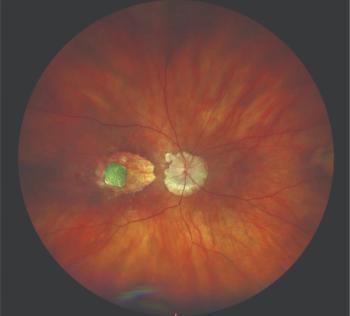
The promise of VEGF inhibitors in ophthalmology: Opportunities and challenges
Anti-vascular endothelial growth factor (VEGF) therapy has swept through ophthalmology over the past several years, dramatically changing clinicians? approach to the treatment of neovascular age-related macular degeneration (AMD). Although this form of therapy has been shown to be effective in several clinical trials, much remains to be learned about its clinical application.
Anti-vascular endothelial growth factor (VEGF) therapy has sweptthrough ophthalmology over the past several years, dramaticallychanging clinicians’ approach to the treatment of neovascularage-related macular degeneration (AMD). Although this form oftherapy has been shown to be effective in several clinicaltrials, much remains to be learned about its clinicalapplication.
At a recent continuing education symposium held during theAmerican Academy of Ophthalmology meeting in Atlanta, a group ofexperts explored the opportunities and challenges posed by VEGFinhibitors. The evening program was held at the 755 Club atTurner Field.
Program chairman and moderator David S. Boyer, MD, began theprogram with an update on trials and studies. Dr. Boyer isclinical professor at the Keck School of Medicine, University ofSouthern California, Los Angeles. He said that the currentlyavailable anti-VEGF therapies appear to be safe both ocularly andsystemically, although in one study there was a trend toward anincreased stroke rate in a subset of patients with a history ofstroke. Only long-term, large studies will offer a clarifiedpicture of the safety and effectiveness of these therapies, headded.
Dr. Boyer discussed results of the SAILOR (Safety Assessment ofIntravitreal Lucentis for AMD) study, a phase IIIb, 12-month,multicenter trial of ranibizumab (Lucentis, Genentech). SAILORhad two cohorts of patients. Cohort 1 consisted of patientsrandomly selected to receive 0.3 or 0.5 mg of ranibizumab in asingle-masked fashion. Injections were given monthly for 3months, then as-needed based on re-treatment protocol. Cohort 2patients were in an open-label arm and received an initial 0.5-mginjection followed by re-treatment at physiciandiscretion.
Dr. Boyer reported that patients receiving both 0.3- and 0.5-mginjections had similar rates of APTC events, myocardialinfarction, and vascular death. A trend toward higher stroke andnonvascular death rates seen in the 0.5-mg group was notstatistically significant. In Cohort 1, visual acuity increasedover the first three injections then decreased through month 12,and the 0.5-mg dose tended to be more effective.
Another anti-VEGF agent, pegaptanib (Macugen, Pfizer/OSIPharmaceuticals), was the subject of the VISION trial (VEGFInhibition Study in Ocular Neovascularization). This trialincluded patients with a range of angiographic subtypes, lesionsizes, and visual acuities. In the first year of the study,patients were randomly assigned to receive one of three doses ofpegaptanib: 0.3, 1 mg, or 3 mg, or sham injections, every 6weeks. After 3 years, patients who had received active treatmentwith the 0.3 or 1 mg doses throughout the study were allowed tocontinue treatment for a further 18 injections over 108weeks.
Despite the limited number of patients (n = 60) receivingtreatment during year 4 of the trial and the absence of a controlgroup, analysis of safety data suggests that the results areconsistent with previous reports, Dr. Boyer said. There was noevidence of an increased risk of ocular or systemic adverseevents.
Several new phase III AMD trials using anti-VEGF therapy areenrolling or have recently completed enrollment. The CATT study(Comparison of AMD Treatment Trials) is an evaluation ofranibizumab versus bevacizumab (Avastin, Genentech) that hasrecently begun enrolling patients. Both the DENALI and RADICALtrials involve combination photodynamic therapy (PDT) andranibizumab; two arms of the RADICAL study include patientsrandomized to PDT, ranibizumab, and dexamethasone.
Yet another therapeutic approach is a fusion protein (VEGFTrap-Eye, Regeneron Pharmaceuticals/Bayer HealthCare). Recentlyreported results of a phase II study showed that the proteinproduced lasting improvements in visual acuity and biologicmeasures of neovascular disease at 1 year.
Clinical trials of anti-VEGF therapies have tested an assortmentof dosing strategies. Among the questions raised by these trialsare whether it matters when treatment is started, how often it isgiven, and how closely these strategies should be followed in"real-world” clinical settings, according to Anne Fung, MD, ofCalifornia Pacific Medical Center in San Francisco. Forranibizumab monotherapy, regimens include monthly dosing perlabel, PIER per label, PrONTO style, and treat and extend. It isimportant to realize that no one treatment approach will beappropriate or acceptable to all clinicians or allpatients.
In PIER, patients received 0.3 or 0.5 mg ranibizumab or shaminjections monthly for 3 months followed by quarterly doses for atotal of 24 months. The package insert calls for four consecutiveinjections monthly, then quarterly treatment. Comparing theresults of PIER to the ANCHOR and MARINA studies, which usedmonthly dosing, only 8% of eyes in PIER had a gain of ≥15letters at 2 years, compared with 41% in ANCHOR and 33% inMARINA, Dr. Fung said.
In the PrONTO study, optical coherence tomography (OCT) was usedto guide re-treatment decisions following an initial phase ofthree consecutive monthly doses of ranibizumab. Among patientswho completed the 2-year follow-up, the outcomes were similar tothose of MARINA and ANCHOR but with a reduced frequency ofinjections.
The treat and extend model of therapy is another strategy forreducing the need for monthly visits. Patients receive threemonthly injections then begin increasing the interval betweendoses by 2 weeks at a time. Visual acuity, OCT, and dilatedfundus examination are performed at every visit. If no subretinalfluid is visible during the examination, the interval betweeninjections is extended by 2 weeks; if exudation appears, theinterval is shortened by 2 weeks.
The rationale behind this approach is that most patients have apattern of response to treatment, Dr. Fung said, and once it hasbeen identified their treatment schedule can be tailored so thatthey are unlikely to have lengthy periods of potentially harmfulactivity. This relatively new approach seems to blend the bettertraits emerging from the various clinical trials, sheadded.
Although anti-VEGF treatment for AMD is becoming mainstream, withtwo agents on the market having received FDA approvalspecifically for this condition, this therapeutic approach mayhave other ophthalmic applications, for example in the treatmentof diabetic macular edema (DME), central retinal vein occlusion(CRVO), and branch retinal vein occlusion (BRVO).VEGF has been shown to be a critical stimulus in the pathogenesisof both DME and RVO, according to Quan Dong Nguyen, MD, MSc,assistant professor of ophthalmology at the Wilmer Eye Institute,Johns Hopkins University School of Medicine, Baltimore.
Studies have evaluated pegaptanib, bevacizumab, and ranibizumabfor the treatment of DME, and results have been encouraging, Dr.Nguyen said. Recently reported findings from the READ-2 study(Ranibizumab for Edema of the Macula in Diabetes) show thatpatients treated with the anti-VEGF agent experiencedsignificantly greater improvements in visual acuity at month 6than patients randomly selected to receive laser photocoagulationor a combination of the two treatments.
The fusion protein also is being evaluated in patients with DME,Dr. Nguyen said, while ranibizumab for macular edema secondary toretinal vein occlusion also is being assessed in an ongoing studyof the drug’s bioactivity and pharmacodynamics. To date,ranibizumab has been well tolerated in patients with DME due toeither CRVO or BRVO and has resulted in improvements in visualacuity. Investigators are continuing follow-up studies todetermine whether or when patients stabilize and no longerrequire injections and to evaluate long-term visual acuityresults.
David M. Brown, MD, clinical assistant professor of ophthalmologyand director of clinical research at the Greater Houston RetinaResearch Center and The Methodist Hospital, Houston, alsoparticipated in the program. He outlined a number of studiestesting various forms of combination therapy, many involving PDTand an anti-VEGF agent. Although combination therapy makes senseas a means of reducing the number of injections patients receive,no consensus has yet emerged on which combinations seem to bemost effective or how the different therapies should beadministered, Dr. Brown said. He also mentioned that while manycompanies are investigating sustained release anti-VEGF therapy,it seems unlikely that such a drug will be available soon.
The growing use of anti-VEGF therapy has implications for thebusiness side of the ophthalmic practice as well as the clinicalside, said Kirk A. Mack, COMT, CPC, COE, senior consultant withthe Corcoran Consulting Group, a firm headquartered in SanBernardino, CA. As the frequency of intravitreal injectionsincreases, practices need to adopt strategies for efficientpatient flow, whether it is "one-stop shopping” with patientsreceiving exams and injections on the same day or order and pickup, in which the exam and injection are performed on differentdays.
Mack also advised clinicians to monitor coverage guidelines intheir states for intravitreal injections, including the off-labeluse of bevacizumab (Avastin, Genentech), as they can changefrequently. The correct use of the CPT modifier 25 in connectionwith wet AMD patients also is essential to receiving appropriatereimbursement. Modifier 25 pertains to significant evaluation andmanagement services by the same physician on the date of a globalprocedure.
This continuing medical education activity was jointly sponsoredby the New York Eye and Ear Infirmary and cme², inpartnership with Ophthalmology Times, and was supportedthrough an unrestricted educational grant from Genentech.
Newsletter
Don’t miss out—get Ophthalmology Times updates on the latest clinical advancements and expert interviews, straight to your inbox.





